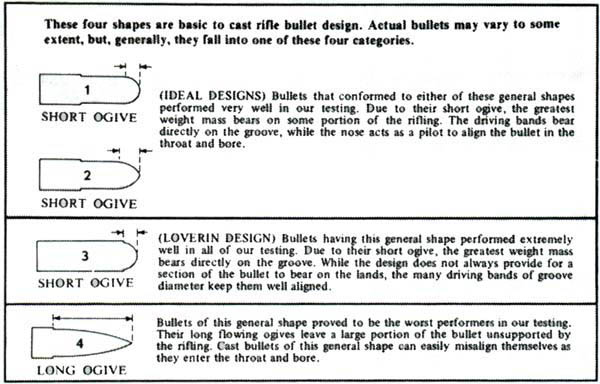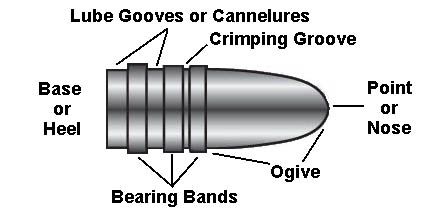
The first three digits of the mould number are the diameter that the bullet is to be sized to. The mould will cast a bullet from .001 to .003 larger to allow for sizing.Undersized bullets (mould number contains "U") must be used to size to .308 or other bore diameters. An undersize mould will cast a bullet approximately .002 smaller than standard moulds.
Precession
For an explanation of the better theoretical benefit of a rounded nose, compared to a pointed nose, look up "New Exact Small Arms Ballistics" by Art Pejsa. In short, as the mose becomes blunter, the Center of Precession moves back towards the Center of Gravity. Obviously, a wadcutter has great potential accuracy, but not so great BC. The calculation of Cp is too advanced for the book, and is not included. Pity.
Epicyclic Swerve
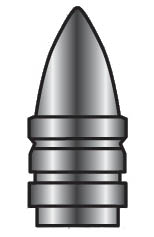 The perfect
aerodynamic lines of this bullet make it potentially, at least, the
most accurate of all. But it lacks the inherent stability of somewhat
blunter shapes. And to become stabilized it often needs higher velocity
than would be required with a blunt bullet.
The perfect
aerodynamic lines of this bullet make it potentially, at least, the
most accurate of all. But it lacks the inherent stability of somewhat
blunter shapes. And to become stabilized it often needs higher velocity
than would be required with a blunt bullet.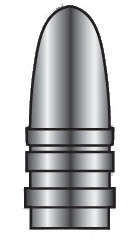 First step toward
greater accuracy is a rounding of the bullet nose. This moves back the
center of gravity, making for increased stability and considerably
improving flight characteristics. Relatively blunt cast bullets
generally give you best results.
First step toward
greater accuracy is a rounding of the bullet nose. This moves back the
center of gravity, making for increased stability and considerably
improving flight characteristics. Relatively blunt cast bullets
generally give you best results.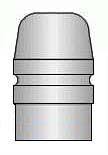 Here, the heel or
base of the bullet is somewhat smaller in diameter than the forward
bands, which are made to fit the bore. The heel fits into the cartridge
neck. Bullets of this kind are not ordinarily sized at all but are shot
as they came from the mould.
Here, the heel or
base of the bullet is somewhat smaller in diameter than the forward
bands, which are made to fit the bore. The heel fits into the cartridge
neck. Bullets of this kind are not ordinarily sized at all but are shot
as they came from the mould.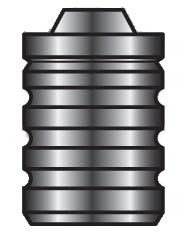 A clean hole in paper
targets was the original objective of these bullets. But their blunt
silhouette seems to make them easier to stabilize and for that reason
many feel they are more accurate. They also generate more shocking
power upon impact and score clean kills.
A clean hole in paper
targets was the original objective of these bullets. But their blunt
silhouette seems to make them easier to stabilize and for that reason
many feel they are more accurate. They also generate more shocking
power upon impact and score clean kills.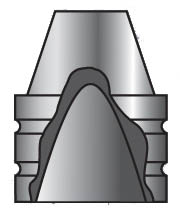 The historic Minie
ball was the ancestor of the modern hollow-base bullet. The explosion
of the powder charge expands the bullet’s hollow base against the
rifling. Only those bullets especially designed as hollow-base bullets
are available in hollow-base style.
The historic Minie
ball was the ancestor of the modern hollow-base bullet. The explosion
of the powder charge expands the bullet’s hollow base against the
rifling. Only those bullets especially designed as hollow-base bullets
are available in hollow-base style.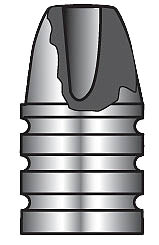 These bullets expand
on contact, causing greatly increased damage to tissue, more sever
shocking power, and quicker, cleaner, kills. Accuracy of these bullets
also makes them popular among benchresters. Practically any bullet
design is available in hollow-point style.
These bullets expand
on contact, causing greatly increased damage to tissue, more sever
shocking power, and quicker, cleaner, kills. Accuracy of these bullets
also makes them popular among benchresters. Practically any bullet
design is available in hollow-point style.This is the long-lived "Gould" 457122 or 456122 330gr (also called the .45-70-330 Express). During the era, "Express" was used to connote a high-velocity (for the time) bullet. Higher velocities were obtained through hollow pointing the bullet..
